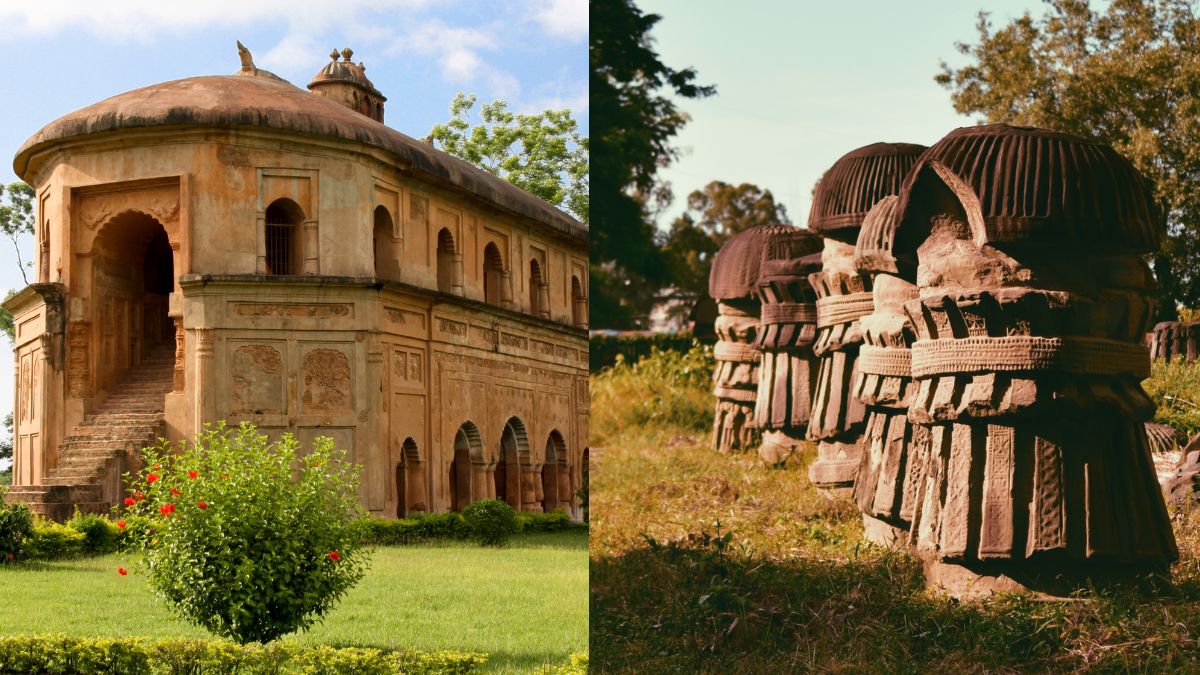India’s northeastern region is a land of breathtaking natural beauty and cultural diversity. While the lush green landscapes and misty hills draw travellers, the region also boasts a rich historical heritage that is often overlooked. The northeastern states are home to a multitude of historical royal monuments and forts that offer a fascinating glimpse into the region’s royal past. Here are the magnificent structures and historical sites that you should visit and that will pique your interest in history:
Travel Back In Time Through These 8 Historical Sites
1. Neermahal, Tripura
The architecture of the Neermahal, only water palace of Tripura lures many tourists.
This architectural beauty rightly derives its name from its location, i.e. the middle of Rudrasagar Lake definitely calm your mind. Have you ever visited here?#TripuraTourism #Neermahal pic.twitter.com/zX3yb2o3wy— Tripura Tourism (@TripuraTourism) April 26, 2022
Situated in the midst of Rudrasagar Lake, Neermahal is a remarkable water palace. The then Tripura King Bir Bikram Kishore Debbarman Manikya in the 1930s constructed this. Its stunning architecture and scenic setting make it a must-visit attraction. The palace is made of red brick and two domed towers give it a distinct look. Neermahal was originally constructed as a summer palace for the royal family of Tripura. It served as a retreat for the royals and provided a cool and serene environment during the hot summer months. Visitors can take a boat ride in the Rudrasagar Lake and get a closer view of the palace. The serene surroundings and the beautiful palace make it a unique experience for tourists.
2. Malinithan, Arunachal Pradesh
Prayed at the ancient Malinithan Temple in Arunachal Pradesh.
Reviewed the restoration work undertaken at this archaeological site which consists of ruins of a famous Hindu temple of the early medieval period. pic.twitter.com/cKGV7PilaV
— Meenakashi Lekhi (@M_Lekhi) February 26, 2023
On the northern bank of the Brahmaputra River in Arunachal Pradesh, there is an archaeological site called Malinithan that has the remains of a Hindu temple from the early mediaeval era. The temple was constructed using granite stones during the time that Hinduism had a significant influence in the area, according to archaeological investigations of the ruins. It was constructed in the 13th and 14th centuries by Chutia kings. During this time, the Chutia rulers began assigning Brahmins to various regions of their realm in exchange for land grants.
3. Semoma Fort, Nagaland
Oct. 9, 1923: The rebuilding of Semoma Fort at Khonoma, India. Much of the stone walls were blasted apart during battles between the British Army and the Naga people in a series of wars from 1850-79. pic.twitter.com/ZTeIcom0Ii
— 100YearsAgoNews (@100YearsAgoNews) October 9, 2023
While it may not be as well-known as some other forts and monuments in India, Semoma Fort has a unique history and represents an important part of Nagaland’s heritage. Strolling around the 700-year-old Angami town of Khonoma, close to Kohima, you come across a modest rough-hewn stone structure that begs the question of why the British dubbed it the strongest fort in the Northeast. Constructed initially in 1825, it repelled British assaults during the initial Anglo-Naga conflict in 1850. The Battle of Khonoma took place in 1879. By placing explosives atop the mountain, the locals managed to flee. After a deadlock, the British agreed to a peace deal, putting an end to fifty years of conflict. Thus, The fort was rebuilt (in 1890, 1919, and 1990) after each destruction, a strong representation of Naga pride.
4. Kangla Fort, Manipur
Much of his regime was dedicated to military ventures. He led a successful expedition to Tripura in 1734, helped the Shan kingdom of Pong against the Burmese and defeated the Mons in request of King Mangdra of the kingdom of Ava.
Pic : Kangla Fort, Manipur, 🇮🇳 pic.twitter.com/8MsiWFJqXe
— Vishweshvar Dev (@VishweshvarDev) March 26, 2021
It holds great significance in the history and culture of Manipur and is one of the most important historical sites in the region. It was the seat of power for the Manipuri kings and is now a historical and archaeological site that offers insights into the region’s past. The surrounding and inner moats, the ancient Govindajee temple, and other remains are excellent examples of Manipur’s rich artistic and architectural legacy.
5. Kachari Ruins, Nagaland
Kachari Ruins, Dimapur Nagaland pic.twitter.com/8vnDyaeSOd
— ChidiKamedi (@ChidiKamediIn) July 10, 2022
The Kachari Ruins in Dimapur are remnants of an ancient civilization that thrived in the region. These ruins provide valuable insights into the architectural and cultural history of the Kachari dynasty. The ruins consist of a sequence of mushroom-shaped pillars that were constructed in the 13th century by the Dimasa Kachari Kingdoms prior to the Ahom invasion. The tallest of which stood at 15 ft. However, the pillars’ origins and purpose are unknown; some are in ruins, while others are standing tall and proud.
ALso Read: Monsoon On North-East India’s Plate Part 2: Bountiful Harvests From Arunachal Pradesh
6. Sibuta Lung, Mizoram
#Sibuta #Lung #Mizoram http://t.co/3bmI6xUI5L – Sibuta Lung is an ancient memorial stone surrounded by a strange.. pic.twitter.com/PSHjffGQpN
— Caper Travel India (@Capertravel) March 29, 2014
This unique stone structure holds great cultural and historical significance for the Mizo people. It is believed to have been erected around the 18th century and is closely associated with the Mizo folklore and their traditional way of life. It is not a fort or palace, but rather a memorial stone. A tale of betrayed love and the need for vengeance is told at the Sibuta Lung memorial.
7. Rang Ghar, Assam
The Rang Ghar Shivsagar, Assam is a royal Sports Pavilion build by Ahom kings in year1744-1751.
It is one of the oldest surviving amphitheatres in Asia. pic.twitter.com/Jx8Qf581Ij— 𝕸ä𝕹ä (@dipshreeee) June 27, 2021
Rang Ghar, which translates to “Amusement House,” is one of the oldest surviving amphitheatres in Asia. Built by the Ahom kings in the 18th century, it was used for royal entertainment, including witnessing traditional games and cultural performances.
8. Talatal Ghar, Assam
Talatal Ghar, Sibasagar Assam pic.twitter.com/IFo46yVnjb
— ChidiKamedi (@ChidiKamediIn) May 1, 2023
Talatal Ghar is an impressive structure of the Ahom dynasty in Sivasagar. This historical monument is famous for its seven stories above the ground and three stories below the ground, serving various purposes, including defence, royal residence, and as a granary.
So, which of these historical sites s are you going to visit first?
Cover image credits: Wikimedia Commons
For more such snackable content, interesting discoveries and the latest updates on food, travel and experiences in your city, download the Curly Tales App. Download HERE.
Good news! We are on WhatsApp! Subscribe to Curly Tales WhatsApp Channel to stay up-to-date with exclusive content and BTS. Join HERE.
First Published: October 27, 2023 7:00 AM



